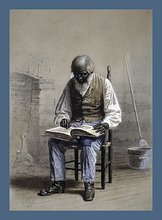In his book, Where Do We Go From Here: Chaos or Community? Martin Luther King offers an explanation of the Black Power Movement of Stokely Carmichael and others that whites may find surprising. Rather than attacking the Black Power movement, which had begun to eclipse the nonviolent methods of the civil rights movement during the 1965 march for James Meredith, he lays the blame squarely at the stalling of the civil rights movement in the face of rising white resistance. The following are excerpts from Where Do We Go From Here, written in 1967, from the volume A Testament of Hope: The Essential Writings and Speeches of Martin Luther King, Jr., edited by James M. Washington.
One year later [from the 1965 passage of the Voting Rights Act], some of the people who had been brutalized in Selma and who were present at the Capiol ceremonies were leading marchers in the suburbs of Chicago amid a rain of rocks and bottles, among burning automobiles, to the thunder of jeering thousands, many of them waving Nazi flags.
A year later, some of the Negro leaders who had been present in Selma and at the Capitol ceremonies no longer held office in their organizations. They had been discarded to symbolize a radical change in tactics.
A year later, the white backlash had become an emotional electoral issue in California, Maryland, and elsewhere. In several southern state men long regarded as political clowns had become governors or only narrowly missed election, their magic achieved with a witches' brew of bigotry, predudice, half-truths, and whole lies.
During the year, white and Negro civil rights workers had been murdered in several southern communities. The swift and easy acquittals that followed for the accused had shocked much of the nation but sent a wave of unabashed triumph through southern segregationist circles. Many of us wept at the funeral services for the dead and for democracy.
During the year, in several northern and western cities, most tradically in Watts, young Negroes had exploded in violence. In an irrational burst of rage they had sought to say something, but the flames had blackened both themselves and their oppressors.
A year later, Ramparts magazine was asserting, "After more than a decade of the Civil Rights Movement the black American in Harlem, Hanynesville, Baltimore, and Bogalousa is worse off today than he was ten years ago...The Movement is in despair because it has been forced to recognize the Negro revolution as a myth."
Had Negroes fumbled the opportunities described by the president? Was the movement in despair? Why was widespread sympathy with the Negro revolution abruptly submerged in indifference in some quarters or banished by outright hostility in others? Why was there ideological disarray?
A simple explanation holds that Negroes rioted in Watts, the voice of Black Power was heard through the land and the white backlash was born; the public became infuriated and sympathy evaporated. This pat explanation founders, however, on the hard fact that the change in mood had preceded Watts and the Black Power slogan. Moreover, white backlash had always existed underneath and sometimes on the surface of American life. No, the answers are both more complex and, for the long, less pessimistic. [empahsis added]
With Selma and the Voting Rights Act, one phase of development in the civil rights movement came to an end. ...For the vast majority of white Americans, the past decade--the first phase--had been a struggle to treat the Negro with a degree of decency, not of equality. White America was ready to demand that the Negro should be spared the lash of brutality and coarse degradation, but it had never been truly committed to helping him out of poverty, exploitation or all forms of discrimination. The outraged white citizen had been sincere when he snatched the whips from the southern sheriffs and forbade them more cruelties. But when this was a to a degree accomplished, the emotions that had momentarily inflamed him melted away. White Americans left the Negro on the ground and in devastating numbers walked off with the aggressor. ...
When Negroes looked for the second phase, the realization of equality, they found that many of their white allies had quietly disappeared. The Negroes of America had taken the president, the press, and the pulpit at their word when they spoke in broad terms of freedom and justice. But the absence of brutality and unregenerate evil is not the presence of justice. To stay murder is not the same thing as to ordain brotherhood. The word was broken, and the free-running expectations of the Negro crashed into the stone walls of white resistance. The result was havoc. Negroes felt cheated, especially in the North, while many whites felt that the Negroes had gained so much it was virtually impuedent and greedy to ask for more so soon. [emphasis added]
The paths of Negro-white unity that had been converging crossed at Selma, and like a giant X began to diverge. Up to Selma there had been unity to eliminate barbaric conduct. Beyond it the unity had be based on the fulfillment of equality, and in the absence of agreement the paths began inexorably to move apart. [emphasis added]
The practical cost of change up to this pointhas been cheap.... Even more significant changes involved in voter registration required neither large monetary nor psychological sacrifice. Spectaclar and turbulent events that dramatized the demand created an erroneous impression that a heavy burden was involved.
The real cost lies ahead. The stiffening of white resistance is a recognition of that fact. The discount education given Negroes will in the future have to be purchased at full price if quality education is to be realized. Jobs are harder and costlier to create than voting rolls. Te eradication of slums housing millions is complex far beyond integrating buses and lunch counters.
Let us take a look at the size of the problem through the lens of the Negro's status in 1967. When the Constitution was written, a strange formula to determine taxes and representation declared that the Negro was 60 percent of a person. Today another curious formula seems to declare that he is 50 percent of a person. Of the good things in life he has approximately one-half those of whites; of the bad, he has twice those of whites. Thus, half of all Negroes live in substandard housing, and Negros have half the income of whites. When we turn to the negative experiences of life, the Negro has double share. There are twice as many unemployed. The rate of infant mortality (widely accepted as an accurate indexi of general health) among Negroes is double that of whites. The equation pursues Negroes even into war. There were twice as many Negroes as whites in combat in Vietnam at the beginning of 1967, and twice as many Negro soldiers died in action (20.6 percent) in proportion to their numbers in the population....
The great majority of Americans are suspended between these opposing attitudes.[:] They are uneasy with injustice but unwilling yet to pay a significant price to eradicate it.
The persistence of racism in depth and the dawning awareness that Negro demands will necessitate structural changes in society have generated a new phase of white resistance in North and South. Based on the cruel judgement that Negroes have come far enough, there is a strong mood to bring the civil rights movement to a halt or reduce it to a crawl. Negro demands that yesterday evoked admiration and support, today--to many--have become tiresome, unwarranted, and a disturbance to the enjoyment of life. Cries of Black Power and riots are not the causes of white resistance, they are consequences of it. (continued)
Subscribe to:
Post Comments (Atom)



No comments:
Post a Comment